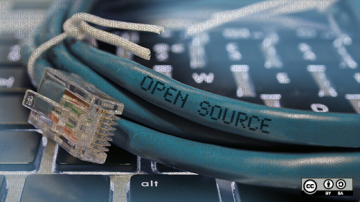I gave a talk about multi-architecture container images at LISA19 in October that included a lengthy live demo. Rather than writing out 30+ commands and risking typos, I decided to automate the demo with a shell script.
The script mimics what appears as input/output and runs the real commands in the background, pausing at various points so I can narrate what is going on. I'm very pleased with how the script turned out and the effect on stage. The script and supporting materials for my presentation are available on GitHub under an Apache 2.0 license.
The script
#!/bin/bash
set -e
IMG=thedoh/lisa19
REGISTRY=docker.io
VERSION=19.10.1
# Plan B with GCR:
#IMG=dulcet-iterator-213018
#REGISTRY=us.gcr.io
#VERSION=19.10.1
pause() {
local step="${1}"
ps1
echo -n "# Next step: ${step}"
read
}
ps1() {
echo -ne "\033[01;32m${USER}@$(hostname -s) \033[01;34m$(basename $(pwd)) \$ \033[00m"
}
echocmd() {
echo "$(ps1)$@"
}
docmd() {
echocmd $@
$@
}
step0() {
local registry="${1}" img="${2}" version="${3}"
# Mindful of tokens in ~/.docker/config.json
docmd grep experimental ~/.docker/config.json
docmd cd ~/go/src/github.com/lisa/lisa19-containers
pause "This is what we'll be building"
docmd export REGISTRY=${registry}
docmd export IMG=${img}
docmd export VERSION=${version}
docmd make REGISTRY=${registry} IMG=${img} VERSION=${version} clean
}
step1() {
local registry="${1}" img="${2}" version="${3}"
docmd docker build --no-cache --platform=linux/amd64 --build-arg=GOARCH=amd64 -t ${REGISTRY}/${IMG}:amd64-${VERSION} .
pause "ARM64 image next"
docmd docker build --no-cache --platform=linux/arm64 --build-arg=GOARCH=arm64 -t ${REGISTRY}/${IMG}:arm64-${VERSION} .
}
step2() {
local registry="${1}" img="${2}" version="${3}" origpwd=$(pwd) savedir=$(mktemp -d) jsontemp=$(mktemp -t XXXXX)
chmod 700 $jsontemp $savedir
# Set our way back home and get ready to fix our arm64 image to amd64.
echocmd 'origpwd=$(pwd)'
echocmd 'savedir=$(mktemp -d)'
echocmd "mkdir -p \$savedir/change"
mkdir -p $savedir/change &>/dev/null
echocmd "docker save ${REGISTRY}/${IMG}:arm64-${VERSION} 2>/dev/null 1> \$savedir/image.tar"
docker save ${REGISTRY}/${IMG}:arm64-${VERSION} 2>/dev/null 1> $savedir/image.tar
pause "untar the image to access its metadata"
echocmd "cd \$savedir/change"
cd $savedir/change
echocmd tar xf \$savedir/image.tar
tar xf $savedir/image.tar
docmd ls -l
pause "find the JSON config file"
echocmd 'jsonfile=$(jq -r ".[0].Config" manifest.json)'
jsonfile=$(jq -r ".[0].Config" manifest.json)
pause "notice the original metadata says amd64"
echocmd jq '{architecture: .architecture, ID: .config.Image}' \$jsonfile
jq '{architecture: .architecture, ID: .config.Image}' $jsonfile
pause "Change from amd64 to arm64 using a temp file"
echocmd "jq '.architecture = \"arm64\"' \$jsonfile > \$jsontemp"
jq '.architecture = "arm64"' $jsonfile > $jsontemp
echocmd /bin/mv -f -- \$jsontemp \$jsonfile
/bin/mv -f -- $jsontemp $jsonfile
pause "Check to make sure the config JSON file says arm64 now"
echocmd jq '{architecture: .architecture, ID: .config.Image}' \$jsonfile
jq '{architecture: .architecture, ID: .config.Image}' $jsonfile
pause "delete the image with the incorrect metadata"
docmd docker rmi ${REGISTRY}/${IMG}:arm64-${VERSION}
pause "Re-compress the ARM64 image and load it back into Docker, then clean up the temp space"
echocmd 'tar cf - * | docker load'
tar cf - * | docker load
docmd cd $origpwd
echocmd "/bin/rm -rf -- \$savedir"
/bin/rm -rf -- $savedir &>/dev/null
}
step3() {
local registry="${1}" img="${2}" version="${3}"
docmd docker push ${registry}/${img}:amd64-${version}
pause "push ARM64 image to ${registry}"
docmd docker push ${registry}/${img}:arm64-${version}
}
step4() {
local registry="${1}" img="${2}" version="${3}"
docmd docker manifest create ${registry}/${img}:${version} ${registry}/${img}:arm64-${version} ${registry}/${img}:amd64-${version}
pause "add a reference to the amd64 image to the manifest list"
docmd docker manifest annotate ${registry}/${img}:${version} ${registry}/${img}:amd64-${version} --os linux --arch amd64
pause "now add arm64"
docmd docker manifest annotate ${registry}/${img}:${version} ${registry}/${img}:arm64-${version} --os linux --arch arm64
}
step5() {
local registry="${1}" img="${2}" version="${3}"
docmd docker manifest push ${registry}/${img}:${version}
}
step6() {
local registry="${1}" img="${2}" version="${3}"
docmd make REGISTRY=${registry} IMG=${img} VERSION=${version} clean
pause "ask docker.io if ${img}:${version} has a linux/amd64 manifest, and run it"
docmd docker pull --platform linux/amd64 ${registry}/${img}:${version}
docmd docker run --rm -i ${registry}/${img}:${version}
pause "clean slate again"
docmd make REGISTRY=${registry} IMG=${img} VERSION=${version} clean
pause "now repeat for linux/arm64 and see what it gives us"
docmd docker pull --platform linux/arm64 ${registry}/${img}:${version}
set +e
docmd docker run --rm -i ${registry}/${img}:${version}
set -e
if [[ $(uname -s) == "Darwin" ]]; then
pause "note about Docker on Mac and binfmt_misc: binfmt_misc lets a mac run arm64 binaries in the Docker VM"
fi
}
pause "initial setup"
step0 ${REGISTRY} ${IMG} ${VERSION}
pause "1 build constituent images"
step1 ${REGISTRY} ${IMG} ${VERSION}
pause "2 fix ARM64 metadata"
step2 ${REGISTRY} ${IMG} ${VERSION}
pause "3 push constituent images up to docker.io"
step3 ${REGISTRY} ${IMG} ${VERSION}
pause "4 build the manifest list for the image"
step4 ${REGISTRY} ${IMG} ${VERSION}
pause "5 Push the manifest list to docker.io"
step5 ${REGISTRY} ${IMG} ${VERSION}
pause "6 clean slate, and validate the list-based image"
step6 ${REGISTRY} ${IMG} ${VERSION}
docmd echo 'Manual steps all done!'
make REGISTRY=${REGISTRY} IMG=${IMG} VERSION=${VERSION} clean &>/dev/null









Comments are closed.